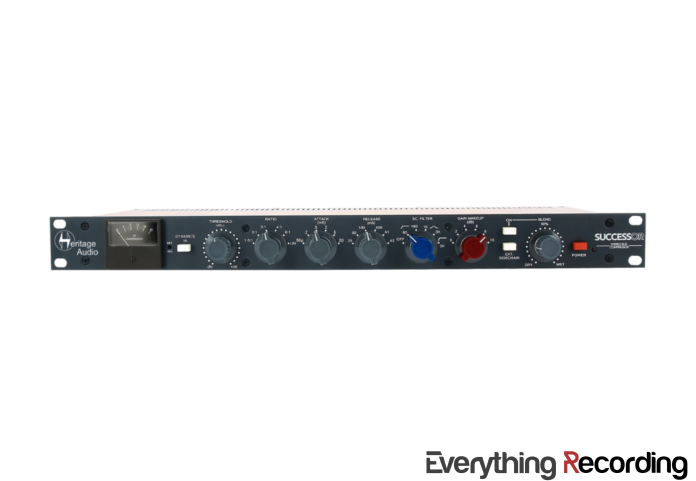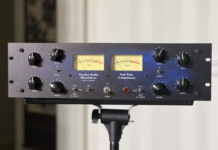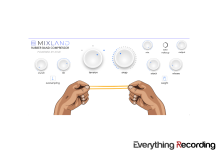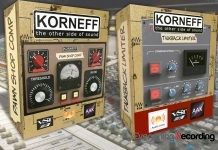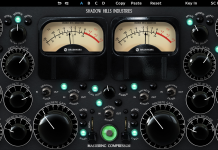There are GearSlutz – and then there are SpankSkankz. B. Church’s NYC home studio plays home to over a dozen analog compressors. For his thoughts on Heritage Audio’s Neve-inspired Successor Bus Compressor, read on.
JUSTIFY MY LOVE
Let me peel back the curtain here on how things work in the editorial corners of the pro audio world for you for a second. The general gist of it is this: Company develops product. Company releases product. Company markets product. Part of that marketing ecosystem is sending review units or NFR copies out to websites like EverythingRecording.com and hope we’ll say something nice.
Let’s temporarily set aside the bottom-feeders who simply copypasta press releases to sell ad units and clicks. They know who they are and don’t care about their status as lowly barnacles. But anyways…
In the world of hardware, there is often a carrot dangled in the form of a steeply discounted price should the reviewer choose to keep it. And, though unspoken, there’s a subtle urging that in return, you’ll focus on the unit’s high notes and breeze politely past the low ones. And we have certainly returned our fair share of units and iLok serials, saying in our very best Russian accent, “ees not for us.“
This is not one of those reviews. Heritage Audio did not contact us, nor we them.
It’s important to point out that editorializing gear is not our day job. We’re engineers, producers, musicians, and all-around GAS-afflicted studio dwellers who still get emotionally tumescent at the latest whoozits and whatzits. The staff of EverythingRecording have sunk a collective hundred grand-or-more into our home studios, proving the calculus of gear acquisition as, “the amount of you need is the amount you have plus one more.” Oh, and that doesn’t even count our guitar collections.
Well, yesterday I racked up my new Heritage Audio Successor. The one I bought and paid for with my own money, not the one they sent me. And if you just wan’t the TL;DR – it’s awesome. Universally awesome? The awesomest? Well, sorry, then we’ll have to start with…
…MY USUAL LONG-WINDED BACKGROUND
My lifelong search for the perfect 2-bus compressor has seen more stripped rack screws than I’d care to admit. Thirty-or-so years ago, when I first began the pursuit of making my mixes mightier and meatier, a good mixdown compressor would run you thousands. Sure, there were certainly options costing less, even a few that were serviceable (I still have an Aphex Dominator in storage). But rarely ever did they piss in the tall weeds with the big dogs. They didn’t make your mixes sound any better, just louder.
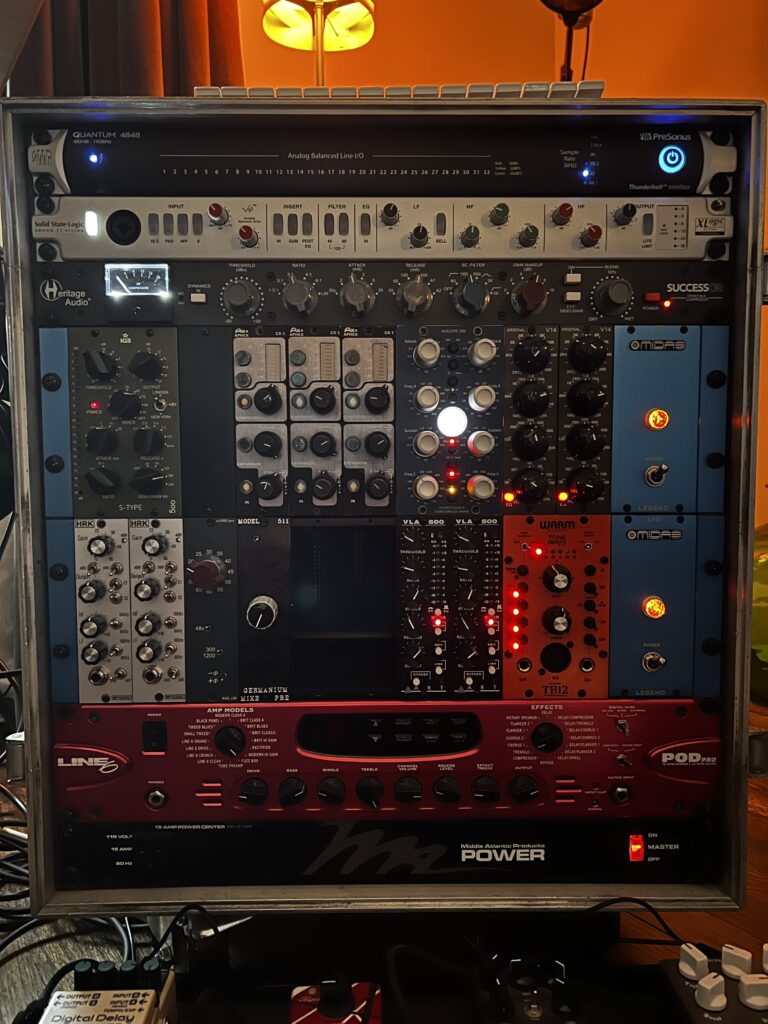
In the years (okay, decades) since, my roving home studio has hosted dozens of these things. Remember the TC Electrionic Finalizer? (Ugh, probably not, you whippersnappers). Well, I was among first in line to buy one and it taught me all kinds of things – notably that buying gear on credit is a horrible business plan. I’ve since owned SSL. Neve. Drawmer. Focusrite. VCA. FET. Tube. Optical. Oh, and we’re not even going to attempt listing the plug-ins that have occupied this position other than to say there have been many.
To me the ultimate bus compressor is one that I can turn on, leave on, and simply mix into it rather than flip it on in the 4th quarter. Nothing crazy, just a little gain smoosh to give the final result a little something something. And I have amassed a fairly handsome collection for a home studio – especially given the space constraints of a NYC spare bedroom.
But GAS is a pesky, chronic condition. You are forever convinced that there’s something else out there that will do it a few db better.
AN BRIT AND A SPANIARD WALK INTO A BAR
Hailing from Madrid, Spain, Heritage Audio have dedicated a sizable part of their product line to recreating the classic circuit designs of one Mr. Rupert Neve. Arguably one of the most, if not the most influential engineers and product designers in our field, Mr. Neve’s many inspired creations have been integral to so many incredible releases that it’d probably be easier to list the ones that haven’t been part of the production process. We could list them all and one day probably should*.
The classic circuits that famously bear his name – notably the 1064, 1073 and 1081 preamps and EQ’s and the 2254/33609 diode bridge compressors, have by now been reverse engineered, recreated, and reimagined by scores of companies big and small alike. Yes, Heritage Audio is among them – and offer these circuits in a handsome portfolio of offerings and price points (the Elite Series notably cuts a few of the pointier corners to put this technology within reach of budget-minded engineers).
(* Lest we forget, Rupert Neve was a lot more than Neve. In the 1980’s he turned his attention to building Focusrite – which at the time were uncompromising, Class-A devices that were the pinnacle of ultra-high bandwidth, unbelievably sterling preamps, eq’s, and dynamics processors.)
BUILDING A BIGGER, BETTER BADASS
This all begs the question then, what’s the big deal with another Neve compressor clone? It’s been done, right? Heck, AMS Neve still produce the 2254 to this day. Well, hold up. The Successor is not a clone of an existing design. While the original Neve blueprint is over fifty years old, the Successor is very much its own thing – and once you properly learn its implementation into your flow, what a joy that thing is.
Heritage Audio have managed to take several nice-to-haves that are found in VCA-based bus compressors these days and augment an “ain’t broke, so don’t fix it” circuit. Packed inside a quite familiar-looking, sturdy Royal Air Force-blue chassis, one can’t help but immediately feel shades of jolly old England, especially with several Marconi knobs festooned on its fascia.
And inside, you’ll find the two most important ingredients of the 2254/33609 design, namely the diagonal diode bridge circuit and two pairs of nice, chunky Carnhills balancing the input and output stages. The original Marinair transformers are long, long out of production – but frankly I would challenge anyone to honestly sit there and pick out the difference. For as much as we talk about the mythical role that these big lumps of iron and wire have on a signal, the variation between brands and core material isn’t exactly profound. Seriously, we are deep, deep into wine country on that one.
But with the similarities covered, it’s the differences that make the Successor far more than a one-trick pony, even if the trick itself is worth the MSRP. A quick scan of the faceplate reveals the numerous “but wait, there’s more” features that would have made Rupert himself proud. First of all, let’s talk attack times. The original 2254 was able to clamp down on transients in 20 milliseconds, which in its day absolutely pantsed their optical and FET-based contemporaries (remember, this is the Pleistocene era before VCA’s appeared). But Heritage Audio have managed to, through exhaustive design, sheer force of will, or ancient Sumerian magick, managed to get that time down to 50 microseconds. Microseconds. As in “a thousandth of a thousandth”. (Fun fact: You know how people say “blink and you’ll miss it”? The average blink is about 330ms. Even a Vari-Mu can handle that.)

That’s faster than fast and you’ll hear it clamp down on percussive material so fast the backlit VU meter is limited by the laws of physics to actually display the gain reduction that’s happening. Too fast? Well, let’s move on.
You’ve got your typical threshold, attack, and release times all, again, selected with classic Neve-styled knobs and detented potentiometers. I can’t overstate how important those clicks are, as easy recall on analog equipment, particularly one that is designed to sit across every mix you do, is a must. The threshold control clicks in 2db steps between its -20 to +20db operating range – left is more, right is less. That’s a good trade-off between big, marked steps and a continuous swing (which would make recall an absolute nightmare). Keep a grease pencil handy or just stick to your precious $29 “sounds almost like” plug-in if this is too much work.
WAIT, IT DOES THAT?
Here’s where it gets interesting – and the Successor truly earns its place as a unique, new take on the classic circuits of days gone by. By way of Spain, we’ve got a virtual paella of features that aren’t on anything like it. Not only does it offer you an 80 and 160hz high pass filter on the sidechain to let kicks, basses, or any other low end-heavy material stay out of the compressor’s detection circuit, but additionally a bell curve at 500 and 3000hz, AND an LPF at 5kHz.

What does this mean for you? Well, hi-pass filters on the sidechain are not new, but they certainly are hard to work without at this point. Being able to trigger the comparator with an overzealous snare drum or peaky vocal are a true godsend, especially since these are both things that push an otherwise polite compressor sound into a pumping, wobbling mess. And for those deaf, former drummer engineers who just don’t realize how loud the cymbals are in the mix? The LPF setting makes your mix listenable for the rest of us.
We could dedicate several more paragraphs to what a “well, duh!” innovation this new take on a detection circuit is. Truly. I can’t believe this isn’t on every compressor. It’s the sort of thing that is a true savior on mixes that need it. But we’re not done here yet.
Moving further to the right you’ve got your external “sidechain in” switch and, again, this is something not found on the designs that inspired the Successor. But you’ve also got output attenuation in six stepped points from 0 – 10db. This is not adding gain (which would add to your noise floor), but attenuating it. Good to know. But just to its right, you’ll find the holiest of holies, the blend knob. Yes, a Neve-styled compressor with a switchable dry/wet mix – also with satisfying clicks between each point for easier recall. Switch it out and the signal bypasses this stage entirely, or pop it in and find the perfect parallel blend – an absolute miracle for drum bus duties.

Flip around back and you’ll find the usual array of XLR inputs and outputs, sidechain input and output on balanced TRS connections, and a five pin connector for the unit’s external power supply. (Oh, boy. Here we go.) Yes, the Successor has a line lump. I should imagine that the trade-off here is that Heritage Audio made the decision to make this unit a single rack space – and in doing so sacrifices had to be made. Remember, there are four – yes, count ’em, four – transformers inside of this thing. And diode bridge topology can be prone to noise compared to its VCA brethren. Big power supplies mean big torroids, which can impart noise if not well-shielded. And with a clown car of wires, trafos, diodes, and transistors inside the Successor already? Well, there you go.
As a final note on the hardware itself, the build quality is excellent. Just picking it up out of the box, you’ll be surprised at this meatball’s heft. The pots and switches click with authority, while the powder-coat surface and chassis elicit the overbuilt outboard of decades long gone by. And even if this makes no discernible difference on the actual audio quality, it does inspire confidence. Of all the things besides the sound Neve are known for? They are built like tanks – and Heritage Audio seem to be up for the long haul.
RACK ME UP BEFORE YOU GO-GO
The diode bridge “sound”, such as it is, is a different shade of compression than many engineers are typically used to. With exception of digital look-ahead technology, you’ll be hard pressed to find anything that can swoop in faster. As the design intent is bus compression, it’s important to point out that a majority of us rely on that oh-so-well-known “gluey” quad-VCA sound. Going into a listening test expecting the same sound or results is going to leave you scratching your head – and I can’t draw enough lines underneath the fact you’ll need to think differently about how you put the Successor to work.

I pulled up a track that has been, for whatever reason, a particularly treacherous one to mix. A lot of elements going on, from a live drum kit to its augmented samples. All told maybe eight tracks of main guitar with flourishes coming in and out throughout the song’s five minutes. A bass guitar track that’s just too roaring to be subdued and tossed in the corner. Densely layered vocals, a Moog Taurus holding up the rhythm guitars, a wispy OSCar synth lead washing over and around, and a fair amount of reverb to truly make it all cavernous. All told? 47 inputs at mix. For me? That’s a lot.
My go-to mix bus compressor is the IGS Audio S-Type – a very fine SSL-inspired 500 series unit, as well as a pinch of the Oxford Inflator and Waves L2 just to ensure no digital overs. The IGS was definitely doing its grabby, gluey thing we all know and love. Could you hear it working? Yes, most definitely. Heavy music is not known for pulling punches and that applies just as much to the way it’s recorded and mixed.
SUCCESS… OR?
Switching the master bus compressor to the Successor was not an immediate parting of the clouds. In fact, with the exact same ratio, threshold, attack and release? It sounded blown out and brown. Murky. Just… bad. But there is no bad gear, only bad engineers. Seriously. Andy Wallace could make a better mix than me with a stock copy of Reaper and nothing else. So I did the smartest, dumbest thing I could: I saved a copy of the session and literally zeroed the thing out. Not just the mix bus – the whole thing. Every last EQ, insert, sub group… all of it. Every fader pulled to null. Every effect send and subgroup deleted. We’re starting over.
Now one philosophy I espouse, and I may be in the minority here, is to ‘mix into’ your compressor (apparently veteran mix engineer Michael Brauer has taken ownership of the practice). This means from the second you begin your mix it’s already strapped across the mix with arms (and diodes) wide open. Like a Creed video, minus the unfortunate realization you’re watching a Creed video. And regardless of what I’m working on that day, I try to leave the settings exactly the same, pretending that the knobs are inaccessible. So if the unit is thwacking and pumping? That means you need to adjust your mix – not your compressor. Oh, and borrowing from the 1176 School of Engineering, you don’t need a threshold knob when you can just lower the level you’re sending it.
I set the Successor at a med. fast attack, slower release, and a (for these days) low 2:1 ratio, then got busy. Getting my drum mix back, I could already hear the circuit going to work. In fact, I opted against patching in my usual weapons of choice on overhead and room mics (the vastly underrated and criminally unknown Aphex CX-1) because the Successor was putting a most marvelous squeeze on the kit as a whole. More on that in a bit.
Once the bass guitar and sample augmentation on the kick and snare were in, it was definitely time to engage the sidechain HPF. Even with only four-or-so db of gain reduction happening, the Successor sounded overworked on the big downbeats. The 80hz setting still produced a little too many artifacts, but switching to 150hz things neatened up considerably.
Pushing the guitar subgroup up into the picture, the Successor started painting a beautiful portrait of the entire soundstage that I hadn’t heard before. In a word? Glorious. Vibrant. Harmonious. Between the Carnhill transformers adding a shimmer of light harmonic distortion and the way the Heritage pulled up the music between the notes, the mix immediately started sounding more… well… “mixed”.
This only left the minor chore of helping a vocal – or in this case – quadruple-stacked vocal – find a place that didn’t feel stapled on top. Now, as a product of Generation X, I have never been one to put the vocals on the tip of your nose. The trick for me has always been to make the words discernable and the emotion behind it intelligible without the mix becoming one part voice, one part “everything else”. Like a guitar that talks (but not the way Peter Frampton did it). Properly leashed with my favorite Elysia xPressor 500, I winced in anticipation and pushed the subgroup up slowly. The result felt like a ray of sunshine after days of rain as they fell right into place. I dare say it was almost too easy, like the Successor was feeding me the answers to the test.
As I continued to automate mix scenes between verses, choruses, bridges, and outros, I noticed just how much a smidgeon of difference between reverb levels could become so apparent. I do a lot of automation, particularly on effect returns. The Heritage truly shines at making a lot out of a little. For all the reverb I might (or might not) use, the last thing in the world I want is for anyone to actually hear it. The best effects, to me, are the ones you only sense.

DUDE… WHERE’S MY MIX?
To that end, I tried switching out the Successor and it was almost as “WTF” as when I first strapped it across the old mix. Seriously. What happened? I’m only shaving off a few points here. All of the sudden, my hours of work sounded like a bad pastiche of vaguely conjoined elements that just so happened to be playing in the same tuning and tempo. Think “first year community college art student collage”. It was wimpy. Anemic. Lame. And oddly enough, the RMS level was actually 3db hotter. Quickly, I smashed that “Dynamics In” button just a little too hard, like someone drinking their first glass of water after three days in the desert. Thankfully, the build quality is as reliable as the sonics.
Though I never use parallel compression on the mix bus, I decided to at least try it out. The result? Well, let’s just say “I never mix with parallel compression on the mix bus”. That’s just me though. Not saying you couldn’t, not saying you shouldn’t, just that I was reminded why I don’t. Frankly, the song at this point sounded damn near ‘finished’ after just a few hours after starting again from scratch. I threw a mix on my Google Drive and popped on a far more real world use case, the dreaded AirPods.
Enjoying my well-deserved afternoon coffee and picturesque walk around Queens (the naked guy who is always eating out of trash cans says ‘hello’), I was enthralled as I A/B’d back and forth between that day’s mix and the one before it. The two were profoundly different, yet both achieved their intended result in their own ways. Usually when mixing through the IGS S-Type’s SSL-on-roids sound, the ‘slammed’ vibe is part of the aesthetic. That’s why so many engineers swear by them, including many who I openly admire and rip off to the best of my ability (Hey, Terry).
The Successor’s mix was a completely different thing, but a quite rich and nuanced one. Very bright and present, but not at all shrill or brittle. In fact, you could look someone dead in the eye and tell them this was recorded old school, tape to console, and they’d likely believe you. The music’s attitude was tempered with a wooly warmth in the lower registers and silky highs up top. Could you say you heard the Successor “working”? Well… yes, but not in the usual “I can hear it pumping”-sort of way.
HEADING DOWN TO POUND-TOWN
I knew that I had to hear the Successor as a dedicated drum bus compressor. Instead of going ten steps back on the same track I’d been listening to all day (fatigue!) I pulled up a drum multitrack from some years back. The recording itself was minimal, just a BeyerDynamic 88 mic on the kick’s front head, a Beta 57 top of the snare, and a spaced pair of slightly-modified Avantone c12 clones (don’t sleep on those, even unmodified they’re pretty spectacular), recorded through a Trident 80B to ProTools. During the recording, we were hitting the Trident’s preamps pretty hard, and not by accident.

Once the Successor got its grubby little mitts on it, the only word was “wow”. My drum bus has a lot of options in mixing, and has certainly been run through all of them. Some favorites? The aforementioned CX-1’s, which are just glorious. Other contenders include some slightly modified ART VLA Opto-comps (the very hard-to-find 500 series ones), DEAD(fx)’s boutique GB-1 Gain Brain clones, Analog Obsession’s very excellent 4K-styled BusterSE, and so on.
Switching the sidechain detector to the quite novel 5kHz LPF, I suddenly heard the drum session I’d heard a million times plus one in a whole different way. The Successor made the drums sound like veritable cannons, every attack followed by a very pleasant, Levee-breaking sustain. And lest the Heritage seem too planted on some sort of Greta Van Fleet retro kick, the rhythms were begging to become next year’s breakbeat loop du jour.
Taking the attack and release times deeper, I was able to push the ratio up into the limiting range – enjoying a musical “squish” that turned attacks into actual notes. You could practically hear the drummer himself breathe. Switching the blend circuit into action, mixing the dry signal in at about 30% let the attacks themselves push their weight around, keeping the rhythm and direction up front while letting all the room’s resonant glory fill out the backseat.
I’d hazard to say that while the Successor might not be the right tool for every stereo mix, it definitely still has a seat at the table in every mixdown. Overheads? Absolutely. Vocals? Giddy-up. Bass guitar? Most definitely.
WHAT’S NOT TO LIKE?
At a $1500-or-so street price, a stereo Neve-inspired compressor with so many modern appointments is a no-brainer for any studio that wants or needs the classic smush of this hallowed sound. The Heritage Successor is unlike any other compressor in your rack or plug-in folder, even if they already contain a 33609/2254 – be it an original or one of the many, many clones or please-don’t-sue-us “re-imaginings”. Is it perfect? Flawless? As it is my job to point out both the highs and the lows, the answer is, “not quite”.
Every compression circuit has an achilles heel and for the diode bridge, that’s noise. Oddly, the Heritage Audio website and manual have no stated signal-to-noise specifications and, looking at the metering in my DAW, I think I might know why. The reality is that yes, it’s a comparatively noisy circuit in its field. With nothing but a bare aux track, my meters read -78dbFS. You’ll really need to crane your ears to hear that. In fact, most home studios would be hard pressed to tell you it was there save for the sliver of signal on the screen. But it should be mentioned here. Not a deal breaker, but it’d be irresponsible of me to tell you it’s whisper quiet. Let’s be real though, this is not a mastering compressor (I guess anything’s a mastering compressor if you master with it), it’s a vintage-inspired “attitude” compressor that doesn’t pretend to be transparent and hospital room clean.

For me, the range of attack times is a little coarse when you realize how focused they are on fast ones. That barely-perceptible 20 microsecond option is frankly too fast to be usable. An attack that fast means the transient gets through for a razor-thin slice of time before the Successor goes to work. In theory? It sounds great. In practice? Not so much. The plosive or transient is cut off after what could only be referred to as a ‘semi-half tick’. If the goal is to not hear the unit working, well, that’s just not useful. Honestly, it sounds broken. This comes at the sacrifice of two or three times in the far more usable range that you might actually use.
My final issue concerns the metering on two fronts. The SIFAM-styled VU meter reads all well and good, but is mounted to the chassis in such a way that the backlight leaks from all around it in dimmer situations with a distracting halo. As this isn’t a review unit that I need to return (and I wouldn’t be returning it regardless), I plan on caulking the edges. Carefully. Speaking of metering, the VU only displays gain reduction. Being able to monitor input or output levels on the unit itself is pretty standard issue, even with the majority of users having their DAW providing a far more granular readout. Still… not a ‘need-to-have’, but definitely a ‘it’d-be-a-lot-cooler-if-it-did’.
HOW THE PAST DEFINES THE FUTURE
If you count yourself among the many home or project studios that is nearly (or completely) in-the-box, but want to add one dedicated bus compressor, the Hertiage Audio Successor is most certainly worth your consideration. The competition is stiff, the field is crowded, and we have reviewed some viable contenders. If I could have one, and only one, stereo analog compressor? I’m not sure. What the Successor has in features and unique sonics, it comparatively lacks somewhat in versatility.
Whereas VCA-based bus compressors will be able to do most things pretty well, the Successor does one thing to absolute perfection. Let’s be clear on this, the Successor is not a unit you can wail on with levels the way you can a 4K-G or 1176 and expect miracles. Like that ex-girlfriend who would tear your head off for asking her if she wanted more ketchup, it’s moody. Seriously, hit it too hard (the compressor, not the girl) and it’s simply too much of a good thing, even with the myriad side-chaining options. I’m the last person you’ll hear using the words “compress” and “responsibly” in the same sentence, but if you want the Successor to be an… ahem… success? You’re not going to see the VU meter thwacking away to the beat.
But if what you’re after is this particular sound – that sound being the inimitable, unmistakable marriage of diodes and iron? You’ve found it. Not only that, you’ve found it in a very feature-rich box with capabilities the Neve 2254/64 simply does not, even with current models. Sonics alone, Heritage Audio has nailed it, and they’ve done so at a very handsome price. Does it sound just like Neve? That’s near impossible to say, as the designs that inspired the Successor have been through tons of revisions – and the vintage units, should you be lucky enough to work on them, have been through fifty years of maintenance. But if you taped a Neve logo over the Heritage one? I’d never suspect a thing.
Can you spend less? Sure, Chinese 4th-shift manufacturer Alctron makes a 2254-clone for CHEAP. SO DOES GOLDEN AGE. But if you’re buying your most mission critical circuit off AliExpress, well… I don’t really even need a snide rejoinder here. And yes, of course, the Neve ‘thing’ here has been RELEASED DOZENS OF TIMES AS A PLUG-IN. But Heritage Audio have been very clever in adding the things that today’s mix engineer need… even if they don’t realize how much they need it.
Remember, I am of unvarnished opinion in this review. I bought the Heritage Audio Successor as a lowly consumer, without the auspices “hey, we sold this to you for half the price… editorialize accordingly”. I don’t have many loyalties to my analog gear either. If something better comes along, I won’t wistfully dab my tears as the Reverb listing for its predecessor goes live.
I set out looking for a new shade of bus compressor. Something that could not only shape the sound of my mixes, but define them. And to that end, you’ll be hearing my Heritage Audio Successor. A lot. It might not be the right tool for every job, but for the right job, it’s one hell of a power tool.
Price (at time of review): $1699.00
For more information and to purchase, please consider our affiliate link (HERE). It doesn’t cost extra to you and helps keep the lights on at Everything Recording HQ.
* Packed to the gills with modern features.
* Extremely attractive price point.
* 78db s/n? That's not exactly whisper-quiet.
* No input or output gain metering.
Be the first to leave a review.



